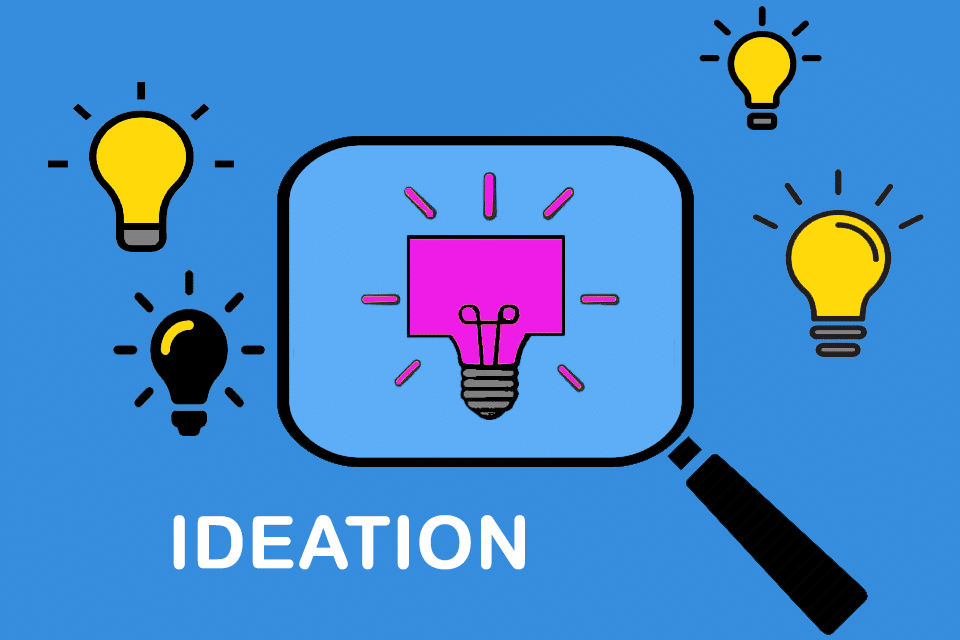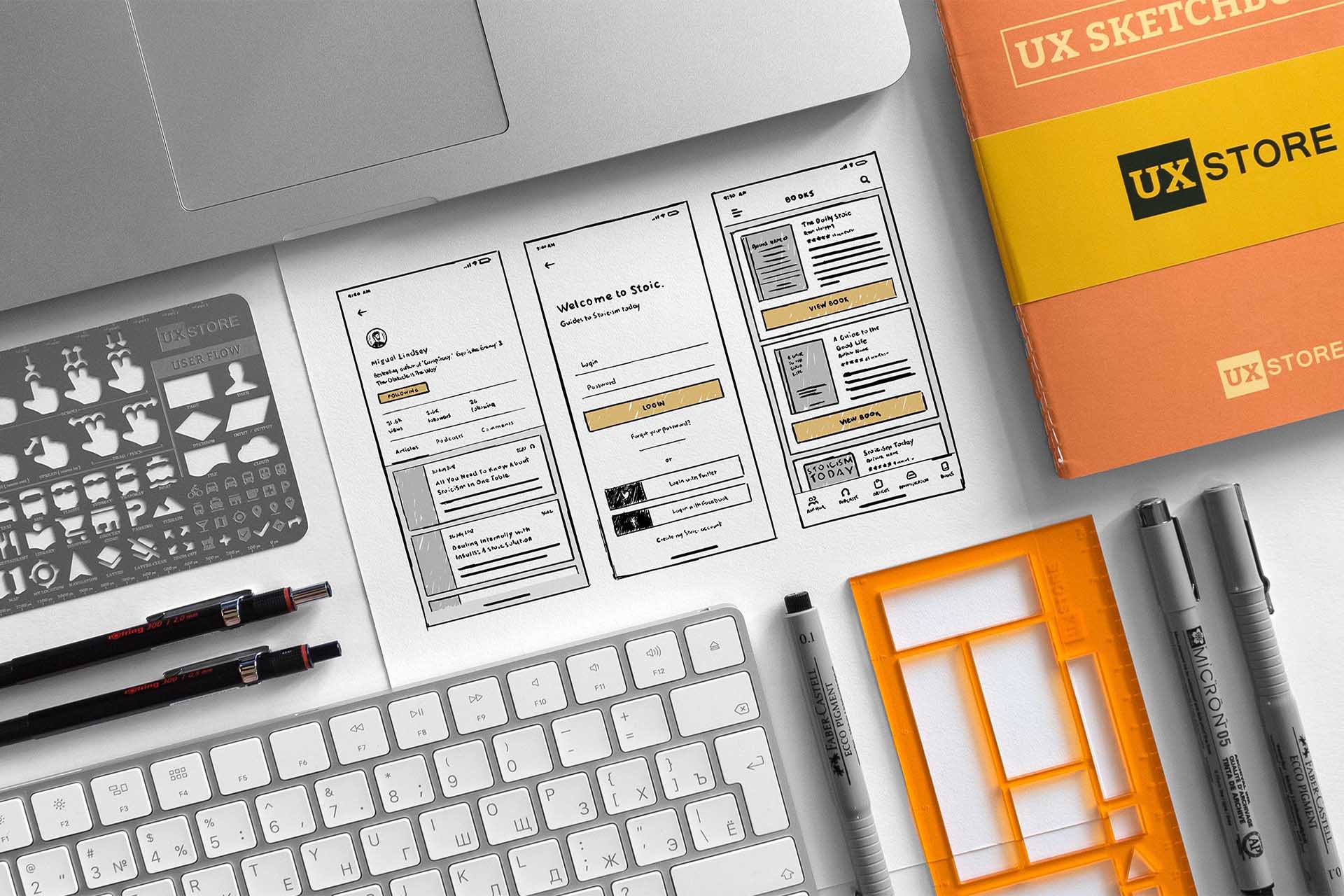What is Ideation?
Table of Contents: Definition – Methods – Tips – Evaluation of ideas – Download – Notes
Smartpedia: Ideation is the process of finding, developing and communicating ideas. In Design Thinking, it is the phase for generating ideas.
Ideation – finding and developing ideas step by step
You have a problem and are looking for a solution. You want to enhance your product and ask yourself what the market needs most urgently. Or you want to increase your sales and are thinking about the best strategy to achieve this. There are many challenges in organisations that call for creative, sensible, implementable, financially viable solutions. In order for these solutions to emerge, it is necessary
- to find suitable ideas,
- develop these ideas and
- communicate them accordingly.¹
In other words: organisations engage in ideation.
- The phase of oversight or inspiration is about the question: “What is the problem?” Ideally, participants develop a deep understanding of the wants and needs of users or customers.
- In the defining or empathy phase, the question “What does the customer really need?” has to be answered. Here, customer wishes are analysed and prioritised.
- The ideation phase is about collecting, developing and evaluating ideas.
- In the building or implementation phase, the ideas are turned into concrete solutions. For example, prototypes are developed or wireframes or click dummies are created.
- The testing phase is about concrete feedback from the users. This is where theory meets concrete practice.
It is important that in design thinking in general and ideation in particular, the focus is on learning by doing – often also referred to as error culture. Getting a better understanding of the users’ wishes and needs through their feedback is a gain, even if the prototype is not developed any further but replaced by another prototype.
Ideation – also a question of method
There is a whole range of methods that can be used in the course of ideation. Here you will find a selection:
- Brainstorming is considered the classic method for generating ideas. “Using the brain to storm a problem” – this is how Alex Faickney Osborn, the inventor of brainstorming, described his creativity technique. Brainstorming is a format for groups to try to solve a task or problem by thinking, discussing and evaluating together.
- Brainwriting is a non-verbal creativity technique for brainstorming in which participants document ideas in writing, share them with each other and develop them individually.
- Braindumping describes the dumping of thoughts and ideas – in writing morning pages and task lists or in working together as a team.
- The headstand technique is a brainstorming format in which questions to be answered are formulated negatively and consolidated answers are turned into positives.
- A similar approach to the headstand technique is reverse brainstorming. “How can we make the problem worse?” takes the place of “How can we solve the problem?”. This is a reversal of classic brainstorming and is accordingly also called “negative brainstorming”. Following the collection of ways to make the problem worse, another reversal occurs: ideas are derived from the findings that prevent the problem from getting worse.
- The Osborn Checklist is a method for developing existing products, concepts, processes or ideas through a series of questions.
- Round-robin brainstorming is a format in which all participants in turn express their opinions and ideas on a common question.
- SCAMPER is a creativity method that uses a series of keywords and questions to facilitate the search for ideas.
- Starbursting is a creativity method that uses questions to illuminate facets of a topic before seeking answers to the questions.
- The 5W1H method is an approach to narrowing down and solving problems. It is based on 6 defined, open-ended questions.
- The 5-Whys method is a root cause analysis tool that explores an issue by asking why questions five times.
- 1-2-4-All – sometimes called the snowball method – is a structured brainstorming format in which the number of participants per round is gradually increased. It belongs to the pool of so-called Liberating Structures.
- The 635 method is a creativity technique in which 6 participants each write down 3 ideas, to which 3 new ideas are added in 5 changes. This is probably the best-known variant of brainwriting.
- Brain-netting is an online brainstorming format in which the brainstorming is decentralised and can be preceded by online braindumping.
- Related to brain-netting is idea napkin. It describes an approach to documenting ideas simply and quickly in five steps.
This list can easily be supplemented with other methods for idea generation and development.
Ideation – tips from practice
There are a number of tips that are useful in the course of ideation. Here are some of them:
- Any idea – however unlikely it may sound – is a good idea. So collect as many ideas as possible.
- Stop criticism. Criticism of ideas and thoughts is just as counterproductive as general criticism of individual idea generators. The goal is appreciative, open and fair communication to solve a problem or task.
- Ideas expressed may be enhanced by all participants. There is no copyright on ideas.
- Some people like to work visually, others like to work haptically. Take into account the wishes and suggestions of the participants for ideation. Someone may suggest LEGO Serious Play as a method – then try this out at the next opportunity (ideally accompanied by an experienced facilitator).
- Think in terms of “yes, and” instead of “yes, but”. This allows for many new ideas and significantly improves the mood among the participants.
- And use timeboxes, because clear timelines provide good orientation in the ideation process.
Of course, it is not surprising that many of the tips also apply to individual methods of ideation.
Ideation – the evaluation of ideas
After collecting ideas, the next step is to evaluate them. Interestingly, although there are approaches that have a specific reference to the evaluation of ideas, the majority of prioritisation approaches are generally valid and suitable for a wide variety of objects such as goals, risks, tasks or requirements. Here you will find a small selection of methods for evaluating or prioritising ideas:
- The ABC analysis is an analysis method for weighting objects according to their importance. It can be used, among other things, for prioritising work packages in project management, in sales for classifying customers and sales areas or in the course of ideation.
- A decision matrix is a tool for selecting the best alternative from various options, taking into account defined criteria. Since in the practice of decision-making not all criteria are always equally important, they are often weighted with separate factors.
- The Pugh matrix is a decision support tool for evaluating competing concepts in comparison to a basic concept. It is based on a set of defined, weighted criteria, the evaluation of alternatives in comparison to a basic solution, the multiplication of the evaluations with the respective weights and the subsequent addition of the weighted evaluations.
- The Kano Model describes the relationship between customer satisfaction and the fulfilment of customer requirements. It shows that individual ideas in the form of concrete product features are of varying importance for customer satisfaction, so that the realisation of corresponding features should be prioritised.
- Trystorming combines brainstorming and rapid prototyping with the aim of validating the usefulness and practicability of an idea as quickly as possible. It is an approach that invites active action in addition to thinking and focuses on the possible implementation of ideas right from the start. This almost automatically leads to thinking about the production of solutions, the implementation of features or the application with customers already during the collection of ideas. And this can pay off in terms of decision-making, the evaluation and realisation of ideas and the subsequent user experience.
Many of the methods mentioned call for the definition of criteria. Theoretically, this sounds much easier than it is in practice. Economic, production-related, technological, structural, temporal or legal factors, for example, can be used as criteria. It may therefore be worthwhile to use a relatively simple method such as the How-Now-Wow matrix to categorise ideas according to their originality and feasibility.
Download the Ideation Whitepaper for free now.
Everything important about Ideation at a glance.
- Definition and tips from practice
- Idea evaluation
- Methods such as reverse and round robin brainstorming, headstand technique, scamper, starbursting, brainwriting, braindumping, Osborn checklist or 1-2-4-All in detail
Knowledge on 17 pages to take away.
Should the methods for generating ideas be changed within the organisation from time to time, or does this tend to confuse participants rather than add value?
Notes:
[1] Communication is an important success factor in the course of ideation. It takes place both internally within the team and organisation and, if necessary, externally to the organisation – e.g. when communicating the idea to partners who help with the development of prototypes or users who are to give feedback accordingly.
Here you can find a German video about Design Thinking.
If you like the article or would like to discuss it, please feel free to share it in your network. And if you have any comments, please do not hesitate to send us a message.
And here you can find additional information from the t2informatik Blog:




